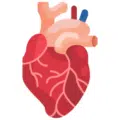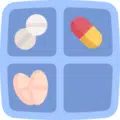Author(s)
Priyasha Patel, PharmD
Debra J Barnette, PharmD, BCPS, BCACP, CDE
Reviewed By
Kathy Tang, Pharm.D.
Kristin Watson, Pharm.D., BCPS AQ Cardiology
Jacintha Cauffield, Pharm.D., BCPS, CDE
About 5 million Americans are currently living with heart failure (HF) and an astounding 24-42% of them also suffer from depression.1,2 One meta-analysis found a greater than 2-fold risk of death in patients with HF and comorbid depression. Depressed patients with HF are more likely to be hospitalized, seek care from emergency rooms, and rack up big bills.3 Not surprisingly, patients with HF and depression have a much lower quality of life when compared to HF patients without depression.4 Clearly, this is big problem. But can we do anything about it?
Pathophysiologic changes in patients with HF and co-morbid depression may increase the risk of morbidity and mortality. There is increased neurohormonal activation, platelet aggregation, levels of serum proinflammatory cytokines, and sympathetic activity with decreased parasympathetic activity.5 However, the impact of antidepressant treatment on cardiosvascular outcomes in patients with HF remains unclear.
In 2010, the SAD HART-CHF (Sertraline Against Depression and Heart Disease in Chronic Heart Failure) study found no differences between sertraline and placebo in terms of the severity of depressive symptoms or a composite cardiovascular (CV) score after 12 weeks of treatment.6 The authors concluded that further studies were needed to identify the optimal medication treatment regimen for depression in patients with HF.
The MOOD-HF (Effects of Selective Serotonin Re-Uptake Inhibition on Morbidity, Mortality and Mood in Depressed Heart Failure Patients) was designed to address the lack of long-term safety and efficacy outcomes data in patients with depression and HF.7 This was a multicenter, double-blind, placebo-controlled randomized trial conducted in Germany. Patients from outpatient HF clinics with a left ventricular ejection fraction (LVEF) of less than 45% and New York Heart Association (NHYA) class II-IV HF with major depression (using the Diagnosis and Statistical Manual of Mental Disorders – IV criteria through a Structured Clinical Interview) were included. Notable exclusion criteria included recent myocardial infarction, acute cardiac decompensation, advanced renal failure, hepatic insufficiency, pregnancy or nursing, and current treatment with drugs known to prolong the QT interval. Patients with a history of antidepressant treatment in adequate dose and sufficient duration to achieve a positive clinical outcome, bipolar affective disorder, substance abuse in last 12 months, severe depressive episode with psychotic features, imminent suicide risk, or dementia were also excluded.
Patients were randomized based on age, sex, depression severity, and time since last hospitalization in a 1:1 ratio to either escitalopram (5mg titrated to 10-20mg once daily; maximum dose 10mg for patients above 65 years) or matching placebo for 24 months. Titration occurred at 3 and 6 weeks post randomization. Baseline characteristics were smilar between the groups. (See Table 1) In addition to pharmacotherapy, counseling and empowerment modules were provided for both groups during telephone encounters and visits. Patients were assessed every 6 months using the 10-item Montgomergy-Asberg Depression Rating Scale (MADRS).
|
Table 1. Baseline characteristics of patients randomized into MOOD-HF trial |
||
|
|
Escitalopram (n=185) |
Placebo |
|
Age, mean, years |
62.2 |
62.3 |
|
Female sex |
24% |
25% |
|
Living alone |
22% |
26% |
|
Blood pressure, mean, mm Hg |
124/76 |
124/76 |
|
New York Heart Association class III-IV |
48% |
58% |
|
Left ventricular ejection fraction, mean |
34.9% |
34.7% |
|
Hospitalization for HF within past 12 months |
66% |
61% |
|
History of depression |
12% |
12% |
|
MADRS score at randomization, mean |
20.2 |
22.0 |
|
9-Item patient Health Questionnare score >16 at screening, percentage |
24 |
24 |
|
9-Item Patient Health Questionnaire sum score at randomization, mean |
12.1 |
12.7 |
|
Kansas City Cardiomyopathy Questionnaire Score (KCCQ) for symptoms, mean |
62.1 |
59.9 |
The primary endpoint was time to a first event of composite of all-cause death or hospitalization (excluding planned hospitalization for non-cardiac causes). Pre-specified secondary outcomes included the MADRS score at 12 weeks, 7-item GAD for generalized anxiety disorder score, and health-related quality of life score (using the KCCQ).
The study was terminated early due to futility. A total of 376 patients were randomized; 4 subjects were not included in the analysis because they withdrew before receiving any study medication. Median participation times were comparable in both treatment groups (around 18 months). At 12 weeks, mean treatment dosages were comparable between the groups ( 15.8 mg of escitalopram and 14.9 mg of placebo). (See Table 2) The primary and secondary outcomes were adjusted for age (<70 or >70 years), sex, PHQ-9 sum score at screening (9-16 or >17) and time from last hospitalization (<4 weeks or >4 weeks before undergoing the screening process). No differences were noted after adjusting for potential confounders.
|
Table 2. Results of the MOOD-HF trial |
||||
|
|
Escitalopram (n=185) |
Placebo (n=187) |
Unadjusted HR |
Adjusted HR (95% CI) |
|
All-cause death or all cause hospitalization |
116 (63%) |
119 (64%) |
0.99 (0.76-1.28) |
0.99 (0.77-1.28) |
|
Cardiovascular hospitalization |
83 (45%) |
88 (47%) |
0.92 (0.68-1.24) |
0.91 (0.67-1.22) |
|
Cardiovascular death |
10 (5%) |
9 (5%) |
1.20 (0.49-2.95) |
Not reported |
|
Hospitalization for worsening depression |
7 (4%) |
16 (9%) |
0.46 (0.19-1.11) |
Not reported |
Changes in depressive symptoms at 12 months are reported in Table 3. Symptom improvement did not differ between escitalopram and placebo. Changes in MADRS Sum Score and PHQ-9 scores were similar in both groups, suggesting remission of depressive symptoms in both groups. Quality of life and health status improved in both groups but there was no difference between groups with the exception of KCCQ Symptom Scale, which had greater improvement in the placebo group.
|
Table 3. Changes from Baseline in Depressive Symptoms |
|||
|
Outcome |
Escitalopram – change from baseline |
Placebo – change from baseline |
P-Value |
|
MADRS Sum Scores at 12 weeks |
Change from 20.2 at baseline to 11.2 |
Change from 21.4 at baseline to 12.5 |
Between group difference -0.9 [95% CI -2.6 to 0.7] p=0.26 |
|
PHQ-9 Sum-Score at 12 months |
-3.5 [-4.5 to -2.4] |
-3.3 [-4.3 to -2.3] |
0.75 |
|
KCCQ Symptoms Score at 12 months |
2.4 (-1.4 to 6.2) |
8.9 (5.6 to 12.3) |
0.01 |
|
KCCQ Overall Summary Score at 12 months |
8.6 (5.0 to 12.2) |
12.7 (9.3 to 16.1) |
0.18 |
At 6 weeks, 11% of escitalopram group had stopped treatment versus 5% placebo (p=0.04). At 12 weeks, 15% of patients in escitalopram group discontinued treatment compared to 7% of placebo (p=0.02). Reasons for discontinuation were not reported. The only notable difference in safety parameters was worsening depression (9 patients in escitalopram versus 21 in placebo, p=0.03).
The authors concluded that escitalopram was safely tolerated in patients with HF and a low EF, however it did not reduce all-cause mortality, hospitalizations, or symptoms of depression. These results were similar to SAD HART-CHF. There was no identifiable benefit from treatment.
Key strengths of the MOOD-HF trial include the study design (randomized, double-blind, intention-to-treat analysis) with the concurrent use non-pharmacologic interventions in both study groups. The study duration was 18 months, significantly longer than SADHART-CHF. Additionally, monitoring of adherence using escitalopram serum levels (although not feasible in clinical practice) revealed satisfactory adherence (73% remained adherent by study visit 6). The mean dose achieved in both study arms was adequate for SSRI therapy.8 Given the narrow patient population enrolled (primarily white men in one European country), the generalizability of these findings is an issue the authors acknowledge.
While use of escitalopram did not improve overall depressive symptoms in this population, individual patients likely benefited. Significantly more patients in the placebo group had worsening of depressive symptoms and hospitalization for worsening depression was also higher in the placebo-treated group (p=0.09). These results suggest there may have been a treatment benefit for a subset of patients.
There are several important caveats that should be noted. First, these were treatment naïve patients and approximately 80% had mild to moderate symptoms. Antidepressant trials in adults have shown a treatment response rate of 50% and placebo response rate of 30%.8 Thus the response rates (with background behavioral therapy) in this trial were comparable to previously documented trials. A narrowing of differences in symptom scores between treament and placebo over time, which has been observed in previous studies, may also be a significant confounder. 9 However, the use of a placebo arm is clearly important.8 Current guidelines recommend focused psychotherapy alone for the initial treatment of mild to moderate depression. 10 The MOOD HF population was fairly complicated. Nearly half of the patients had NYHA Class III-IV HF and approximately two-thirds had at least one HF-related hospitalization in the 12 months prior to enrollment. Lastly, these results simply can’t be applied to patients with severe depression.
The results of the MOOD-HF trial do not provide convincing evidence that drug treatment reduces symptoms of depression or improves CV outcomes in treatment-naïve patients with HF. However, the lack of efficacy could have been due to a variety of confounding variables that cannot be ignored. None-the less, treatment seems to be safe. Therefore, pharmacotherapy with SSRIs should still be offered to patients with moderate to severe depression in the setting of HF and to patients without access to psychotherapy. What do you think? Are antidepressants helpful, harmful, or futile?
- Rosamond W, Flegal K, Friday G et al. Heart disease and stroke statistics – 2007 update: a report from the American Heart Association Statistics Subcommittee. Circulation 2007; 115(5):e69-e171.
- Ghosh RK, Ball S, Gupta A. Depression in heart failure: Intricate relationship, pathophysiology and most updated evidence of interventions from recent clinical studies. Int J Card 2016; 224:170-177.
- Rutledge T, Reis VA, Linke SE, et al. Depression in Heart Failure A Meta-Analytic Review of Prevalence, Intervention Effects, and Associations with Clinical Outcomes. J Am Coll Card 2006; 48(8):1527-37.
- Gottlieb SS, Khatta M, Friedmann E, et al. The influence of age, gender, and race on the prevalence of depression in heart failure patients. J Am Coll Card 2004; 43:1542-1549.
- Thomas SA, Chapa DW, Friedmann E et al. Depression in Patients with Heart Failure: Prevalence, Pathophysiologcal Mechanisms and Treatment. Critical Care Nurse. 2008; 28(2):40-55.
- O’Connor CM, Jiang W, Kuchibhatia M et al. Safety and Efficacy of Sertraline for Depression in Patients with Heart Failure: Results of the SADHART-CHF Trial. J Am Coll Card 2010;56(9):692-699.
- Angermann C, Gelbrich G, Stork S, et al. Effect of Escitalopram on All-Cause Mortality and Hospitalization in Patients with Heart Failure and Depression. The MOOD-HF Randomized Clinical Trial. JAMA. 2016;315(24):2683-2693.
- Hayasaka Y, Purgato M, Magni LR et al. Dose equivalents of antidepressants: Evidence-based recommendations from randomized controlled trials. J Affect Disorders 2015;180:179-184.
- Walsh TB, Seidman SN, Sysko R et al. Placebo Response in Studies of Major Depression. JAMA 2002;287:1840-1847.
- National Guideline Clearinghouse (NGC). Guideline summary: Practice guideline for the treatment of patients with major depressive disorder, third edition. In: National Guideline Clearinghouse (NGC) [Web site]. Rockville (MD): Agency for Healthcare Research and Quality (AHRQ); 2010 Oct 01. [cited 2016 Dec 01]. Available: https://www.guideline.gov



 iForumRx.org is a web-based community of practice designed to inform ambulatory care pharmacy specialists, pharmacy residents, and student pharmacists about high-quality, practice-changing evidence.
iForumRx.org is a web-based community of practice designed to inform ambulatory care pharmacy specialists, pharmacy residents, and student pharmacists about high-quality, practice-changing evidence.